Plymouth
Explore hidden histories, historic photos, and things you never knew about Plymouth from the collections and archives of Historic England.
Discover your local listed buildings and places
Introducing some of Plymouth's most historic sites, included in the National Heritage List for England. Some of these captions have been summarised by AI. Click through for the official List entry. Skip this section and go to place by numbers
Council House and former Civic Centre
Plymouth
Plymouth former Civic Centre is a particularly complete and coherent civic centre which compares well with others of its date including Newcastle Civic Centre, Newcastle-upon-Tyne (listed...
Plympton Castle
Plymouth
Plympton Castle, a motte and bailey castle with shell keep, was vital during Britain’s Norman era, notable for its strategic role in King Stephen's Civil War and rare architectural design.
Plymouth Castle (remains of)
Plymouth
The remnants of Plymouth Castle indicate it was likely built for defense against naval attacks, rather than as a noble residence or royal castle.
Former Barclays Bank Building
Plymouth
The former Barclays Bank building, constructed in 1950-2 to designs by Curtis Green, Son and Lloyd; converted and extended vertically in 2005-7 by Architects Design Group.
Royal Bank of Scotland
Plymouth
The Royal Bank of Scotland, Plymouth, built in 1956-1959 for the National Provincial Bank by the Bank's architects' department, with B C Sherren as Chief Architect.
The Hoe
Plymouth
The Hoe, a historic recreational site in Plymouth, dates back to medieval times. It features public monuments, promenades, and an iconic lighthouse, reflecting its cultural importance.
Civic Square, Plymouth
Plymouth
Civic Square, envisioned by H J W Stirling in 1956, combines pedestrian-friendly design with diverse landscaping materials, offering civic amenity and enhancing urban connectivity in...
Prysten House
Plymouth
Prysten House, dating from around 1498, is an excellent late medieval merchant's house featuring granite fireplaces, oak roof structure, and a courtyard plan.
Theatre Royal Plymouth
Plymouth
The Theatre Royal, Plymouth, built 1979-82 by the Peter Moro Partnership, extended 2013 by Andrzej Blonski. Read the official list entry to find out more.
Officers’ Terrace with attached office wing and basement …
Plymouth
A pair of houses and attached offices forming the surviving part of the Officers' Terrace at Plymouth Dock, later Devonport Royal Naval Dockyard.
Smeaton's Tower
Plymouth
Smeaton's Tower, developed by John Smeaton in 1759 and relocated in 1882, witnessed a suffragette bomb attempt in 1913 linked to Emmeline Pankhurst's activities.
East Ropery, Formerly Spinning House (S 132) , and Attach…
Plymouth
The East Ropery, South Yard, Devonport, is a Grade I listed early 19th-century industrial structure renowned for its fire-proof design and historical significance in naval rope production.
Plymouth Naval War Memorial
Plymouth
The Naval War Memorial at Plymouth, situated at the centre of The Hoe, looking towards Plymouth Sound.
Agaton fort
Plymouth
Agaton Fort is a historically significant Royal Commission fortification near Plymouth, part of Britain's coastal defence system from 1859.
Ernesettle battery
Plymouth
Ernesettle Battery, a Royal Commission fortification, is significant for its strategic military importance and historical association with Britain's 19th-century coastal defenses.
Western Morning News
Plymouth
An integrated newspaper building combining office and production facilities. Read the official list entry to find out more.
Devonport Park
Plymouth
Devonport Park, developed from mid-19th century, features historical designs by William Ponty and F. W. Meyer, with scenic gardens and significant military memorials.
Jewish Burial Ground off Lambhay Hill, Plymouth
Plymouth
A walled Jewish burial ground, with the probable ruins of an ohel.
Devonport Dockyard: The Scrieve Board (S 162)
Plymouth
Former slip, dating from the late C18, with slip cover of 1814-21, after a design by Sir Robert Seppings. The slip was subsequently floored, and used as a 'scrieve board' for ship design.
Cross in grounds of Stentaway House, Billacombe
Plymouth
Pre-Conquest cross and early Christian stone in Devon, merging rare styles prevalent in Cornwall, probably used as late memorial with significant historical and religious symbolism.
Lee Moor Tramway Bridge
Plymouth
The Lee Moor Tramway Bridge is a 19th-century cast iron and timber bridge part of an industrial network essential to the Industrial Revolution.
Coronation Offshore
Off Rame Head / Penlee Point, Cornwall
The offshore section of the English warship Coronation, which capsized near Plymouth in 1691, lies in two wreck parts. Only 22 survived out of 660 crew.
The coastal fortifications of Drake's Island
City of Plymouth
Drake's Island is historically significant for defending Plymouth, with fortifications dating from the 16th century to 1958, showcasing military architectural evolution.
Roman Catholic Cathedral of St Mary and St Boniface
Plymouth
Roman Catholic cathedral. 1855-58 by J A and C F Hansom for Bishop Vaughan; the local builder was named Roberts. The spire added to tower in 1866.
Saltram House
Plymouth
Saltram House is a large country house with a 16th and 17th-century core, remodeled in the 18th century by Robert Adam, featuring fine Neo-Classical reception rooms.
Nos. 10-19 Caroline Place including forecourt walls and r…
Plymouth
One of two planned terraces built circa 1835; rear wings were later added. The front half of No.
Stonehouse Town Wall
Plymouth
The remains of a C15/C16 town wall built as protection for business interests against French raids. It is constructed of coursed limestone and overlooks Plymouth Sound.
Nos. 17 and 18 New Street
Plymouth
A pair of former C17 merchants' houses, one of the which was re-fronted in and converted into a fish warehouse in C19; both buildings were converted into flats in the late C20.
Eastern King battery
Plymouth
Eastern King Point battery, with its original fittings, has historical significance due to its evolution and current use as a naval saluting battery.
Baptist Church
Plymouth
Catherine Street Baptist Church and Hilliard Hall, with an attached covered walkway arcade and caretaker's flat, all set around a cobbled courtyard.
Plympton House
Plymouth
Plympton House, an 18th-century mansion in Plympton, was begun by Sir George Treby and continued by his son. It features formal gardens and a preserved architectural style.
Round barrow on Burrow Hill
Plymouth
The round barrow on Burrow Hill, featuring a war memorial, is a prominent historic monument, notable for its rarity in an urban setting and its cultural significance.
Fort Stamford
Plymouth
Fort Stamford is a key element of Britain's coastal defense, established after the 1859 Royal Commission. It remains significant for its historical and military attributes.
Ford Park Cemetery
Plymouth
A mid C19 cemetery laid out to the design of J R Hamilton and J M Medland of Gloucester. Read the official list entry to find out more.
Plympton War Memorial
Plymouth
A parish war memorial, unveiled in May 1924 and designed by the Rector of St Maurice, Revd. CE Seccombe.
Church of St Simon
Plymouth
The church of St Simon, Plymouth, built 1905-7 to a design by Harbottle Reed, the west end having been completed in 1957. Read the official list entry to find out more.
No 3 Dock, including bollards and capstans
Plymouth
One of four dry docks, first built circa 1758, enlarged and covered over in the mid-C19; it was further enlarged and uncovered in the late C19. Read the official list entry to find out more.
No 2 Dock, including bollards and capstans
Plymouth
One of four dry docks, first built between 1720-30, made into a double lock, enlarged and made into a single dock in the late C19. Read the official list entry to find out more.
Explore more
Search for more listed placesPlymouth through time
This timeline shows the first period of use for buildings and places on the National Heritage List for England, just one of the details recorded for every list entry. Click around to see how Plymouth changes over time. Skip this section and go to aerial photos
Prehistoric Before AD 43
Prehistory covers a million years of human occupation before the Roman invasion and the introduction of writing. Primarily hunter-gatherers of several human species including Neanderthals, the peoples moved across Europe, hunting animals, exchanging ideas and developing complex culture and belief systems including burial rites and astronomical understanding, as at Stonehenge for example.
Early medieval AD 410 to AD 1066
This period, often associated in England with Anglo-Saxons and Vikings, saw a reduction in urban living from the Roman period and increased migration from northern Europe.
Traces of this period can be found in cemeteries, particularly in artefacts and in some of the very early churches, as this period also saw the growth of Christianity in Britain.
Medieval AD 1066 to AD 1540
This period, sometimes known as the Middle Ages, began with the Norman invasion in AD 1066. It saw a significant rise in military and defensive buildings such as castles and earthworks, as well as religious houses dominating a largely agricultural landscape.
The monarchy and Church dominated the period, which also saw the break with the Roman Catholic Church and the English reformation.
Post medieval AD 1540 to AD 1901
The Post-Medieval period brought seismic changes to life in England, with religious reformation leading to the democratization of worship and the destruction of hundreds of religious houses.
In parallel, there was a huge expansion of scientific study and enlightenment that permanently altered the nation's social structure and landscape. Industrialization and mass production lead to wider global trade, emigration, and immigration.
20th century AD 1901 to AD 2000
The 20th century saw an incredible expansion of England's transport networks, with suburban growth shadowing rapid infrastructural expansion. The establishment of state schools, hospitals, and modern technical colleges, with new architectural styles, radically changed the appearance of towns and cities.
Two catastrophic world wars and the 1918 pandemic also brought unprecedented change, altering England's built environment and social structures forever.
Prehistoric Before AD 43
Prehistory covers a million years of human occupation before the Roman invasion and the introduction of writing. Primarily hunter-gatherers of several human species including Neanderthals, the peoples moved across Europe, hunting animals, exchanging ideas and developing complex culture and belief systems including burial rites and astronomical understanding, as at Stonehenge for example.
Early medieval AD 410 to AD 1066
This period, often associated in England with Anglo-Saxons and Vikings, saw a reduction in urban living from the Roman period and increased migration from northern Europe.
Traces of this period can be found in cemeteries, particularly in artefacts and in some of the very early churches, as this period also saw the growth of Christianity in Britain.
Medieval AD 1066 to AD 1540
This period, sometimes known as the Middle Ages, began with the Norman invasion in AD 1066. It saw a significant rise in military and defensive buildings such as castles and earthworks, as well as religious houses dominating a largely agricultural landscape.
The monarchy and Church dominated the period, which also saw the break with the Roman Catholic Church and the English reformation.
Post medieval AD 1540 to AD 1901
The Post-Medieval period brought seismic changes to life in England, with religious reformation leading to the democratization of worship and the destruction of hundreds of religious houses.
In parallel, there was a huge expansion of scientific study and enlightenment that permanently altered the nation's social structure and landscape. Industrialization and mass production lead to wider global trade, emigration, and immigration.
20th century AD 1901 to AD 2000
The 20th century saw an incredible expansion of England's transport networks, with suburban growth shadowing rapid infrastructural expansion. The establishment of state schools, hospitals, and modern technical colleges, with new architectural styles, radically changed the appearance of towns and cities.
Two catastrophic world wars and the 1918 pandemic also brought unprecedented change, altering England's built environment and social structures forever.
Aerial photos of Plymouth
Aerial photography helps reveal secrets of England's changing landscapes that are impossible to see from the ground. Skip this section and go to archive images
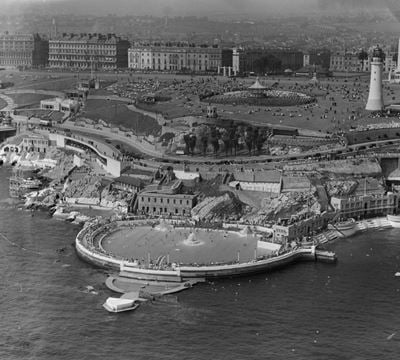
Plymouth
The Hoe, Plymouth, 1937

Plymouth
The Hoe, Plymouth, 1953
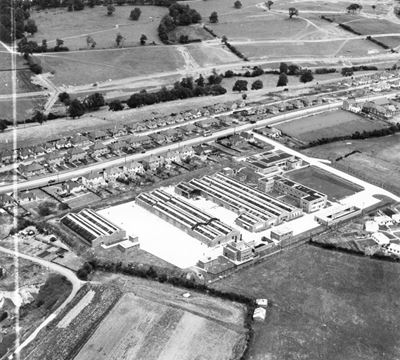
Honicknowle
The Berkertex Clothing Factory, Honicknowle, 1949

Honicknowle
The Berkertex Clothing Factory, Honicknowle, 1949

Plymouth
The Bush Radio Ltd Works at Ernesettle, Plymouth, 1952
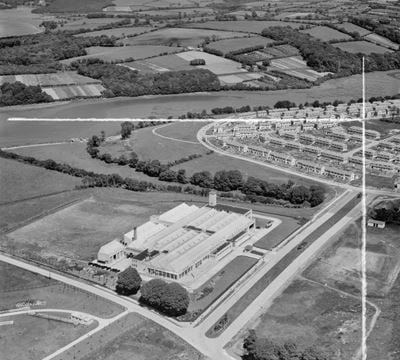
Plymouth
The Bush Radio Ltd Factory at Ernesettle, Plymouth, 1953

Plymouth
The city centre, Plymouth, 1947
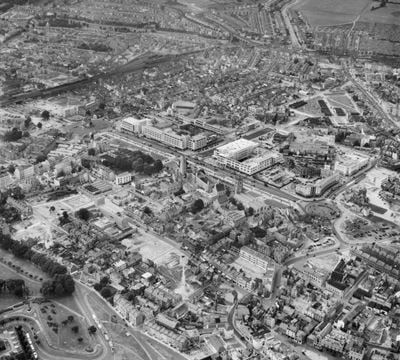
Plymouth
Royal Parade and the city centre, Plymouth, 1953

Plymouth
The Hoe and the city, Plymouth, 1953
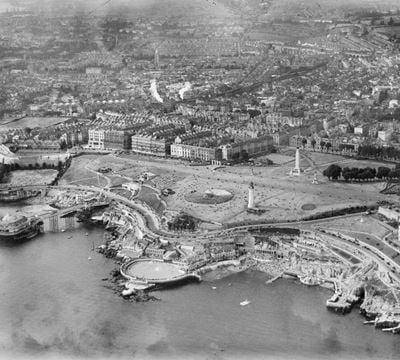
Plymouth
The Hoe, Plymouth, 1937
Plymouth in the Historic England Archive
The Historic England Archive cares for over 15 million images, dating from the 1850s to the present day. Discover stunning images of Plymouth's past. Skip this section and go to stories about heritage
Charles George Harper Collection
City Of Plymouth
Date created: 1892 - 1933
A man in a rowing boat beneath the Custom House on the Barbican
Eric de Mare
Devonport, City Of Plymouth, City Of Plymouth
Date created: 1956
Interior view of number 1 Slip at Devonport Naval Dockyard showing the roof timbers.
John Gay Collection: Modern Architects
Tamerton Foliot, City Of Plymouth, City Of Plymouth
Date created: 1967 - 1975
The modern housing estate at Tamerton Foliot, formerly a small village to the north of Plymouth, but now a suburb of the city
John Gay Collection: Counties
The Hoe, City Of Plymouth
Date created: 1973
A middle-aged couple sitting on the ground with Smeaton Tower in Plymouth behind
John Laing Collection
City Of Plymouth
Date created: 26 Nov 1950
A view of the construction site for Plymouth 'B' Power Station, with Plymouth 'A' Power Station in the background
London, Midland and Scottish Railway Company
West Hoe, City Of Plymouth, City Of Plymouth
Date created: Jul 1887
A view looking south-west from Plymouth Hoe towards Eastern King Point, showing the pavilion of Plymouth Pier, West Hoe Pier and the terraced houses...
Nigel Temple Collection of Postcards of Parks and Gardens
The Hoe, City Of Plymouth, City Of Plymouth
Date created: 1900 - 1920
GENERAL VIEW OF THE SLOPES OF PLYMOUTH HOE
Margaret Tomlinson Collection
The Barbican, City Of Plymouth, City Of Plymouth
Date created: 01 Jan 1943 - 31 Oct 1943
The Governor's House at the Royal Citadel viewed from the south east
John Gay Collection: Counties
The Barbican, City Of Plymouth, City Of Plymouth
Date created: 1973
A group of tourists standing near the walls of the King Charles Bastion at the Royal Citadel, Plymouth, looking towards Smeaton Tower and the coast of...
London, Midland and Scottish Railway Company
Plymouth Hoe, City Of Plymouth, City Of Plymouth
Date created: 05 Jul 1893
A view looking east across Plymouth Hoe towards the Citadel Hill Laboratory of the Marine Biological Association
Nigel Temple Collection of Postcards of Parks and Gardens
The Hoe, City Of Plymouth, City Of Plymouth
Date created: 1920 - 1930
GENERAL VIEW SHOWING PLYMOUTH HOE AND PROMENADE
Margaret Tomlinson Collection
The Barbican, City Of Plymouth, City Of Plymouth
Date created: 01 Jan 1943 - 31 Oct 1943
The doorway at the south end of the north front of the Governor's House at the Royal Citadel
Stories about heritage in your local area
Historic England publishes news, blogs, research, videos, and podcasts celebrating England's rich heritage. Discover the stories we have about Plymouth. Skip this section and go to education
The Life and Work of John Smeaton, the ‘Father of Civil Engineering’
Mentions Smeaton's Tower
Discover the remarkable feats of engineering by British civil engineer John Smeaton.
Ghost Signs: Spooky Remains of a Hidden Past
Mentions 6, The Barbican
Once you’re on the look out for ghost signs, you’ll find they are frequently hidden in plain sight.
10 Historic Sites That Tell the Story of Katherine of Aragon in England
Mentions Church of St Andrew
Explore the significance of places visited or lived in by Katherine of Aragon, the first wife of Henry VIII.
7 Historic Urban Parks and Gardens To Improve Your Wellbeing
Mentions Devonport Park
Parks and green spaces are vital for our mental and physical health.
10 Places That Tell the Story of the Mayflower
Mentions Island House, West Pier
Passengers of the Mayflower laid the foundations for what would become the United States of America.
Where to Find Egyptian Style Architecture in England
Mentions Oddfellows Hall
‘Egyptomania’ was the height of fashion in Regency England. Here are some of the places you can see its impact.
A Brief Introduction to Lidos
Mentions Tinside Lido and Changing Rooms
Increasing water safety concerns in the 1920s inspired the creation of outdoor pools with concrete, tiled tanks and water filtration systems.
6 Spectacular Swimming Pools
Mentions Tinside Lido and Changing Rooms
Dive in and discover some of England’s historic swimming pools.
5 Things You Need to Know About Listing
Mentions Western Morning News
Listing is the term given to the practice of listing buildings, scheduling monuments, registering parks, gardens and battlefields, and protecting...
Built to Brew: 9 Historic Breweries in England
Mentions Brewhouse, Royal William Victualling Yard
Our Neolithic ancestors were brewers, and brewing continued during the Iron Age and into the Roman period.
Suffragettes: Places Where History Happened
Mentions Smeaton's Tower
Following 50 years of campaigning by Suffragists, the Suffragettes pushed for the vote through militant action and civil disobedience.
England’s Record Breaking Heritage
Mentions Western Morning News
The Guinness World Records celebrates 60 years of extraordinary achievements this week, from globetrotting explorers to sports heroes smashing records.
Fishing for Heritage
Mentions Plymouth
Maritime archaeologists worked with fishermen to investigate underwater heritage off the Sussex coast, including a crashed US military aircraft.
Historic England Acquires World-Class Collection Featuring Earliest and Finest Photographs of England
Mentions Plymouth
An important collection of some of the finest earliest landscape photography of England has been added to the Historic England Archive.
30 New Projects Explore England’s Rural and CoastalWorking-Class Heritage
Mentions Plymouth
Funded by Historic England's Everyday Heritage grants programme, these projects will explore untold stories and celebrate the heart of our history.
Introduction to Issue 26
Mentions Plymouth
This issue explores aspects of industrial heritage, Palaeolithic landscapes, and the relationship between intertidal heritage and biodiversity.
Browndown: Training for Trench Warfare in the First World War
Mentions Plymouth
Recent survey has supported protection at one of the best preserved First World War training grounds.
The Lost Roman Road From Chichester To Arundel
Mentions Plymouth
Analysis of lidar and aerial photography leads to the rediscovery of a long-speculated route of a Roman Road.
Investigating the Intertidal Zone
Mentions Plymouth
A pilot study in Plymouth Sound demonstrates the value of researchers in coastal heritage working with marine science in response to climate change.
The English Railway Station
Mentions Plymouth
The first-ever national survey of these iconic structures has been published by Historic England.
Introduction to Issue 15
Mentions Plymouth
Introducing highlights of research from the South East and South West regions and their adjacent waters, along with a national scope archive project.
Biodiversity and Land Use: How Ancient Practices Shaped Britain
Mentions Plymouth
Research exploring how the interplay between the natural environment, climate and human land use has shaped the landscapes of the British Isles.
Public Asked to Help Hunt Ghost Signs This Halloween
Mentions Plymouth
Historic England is inviting the public to share images and information of ghost signs across England on a new online map.
Plymouth's social history through photos
Over 10,000 images from the Historic England Archive have been specially selected and re-captioned for teachers, students, and anyone who wants to learn more about their local area. Skip this section and go to grant-aided places
Western Morning News Offices, Brent Road, Derriford, Plymouth
Period: 1990s (1990 - 1999)
The distinctive offices of the Western Morning News in Brent Road in Derriford.
Western Morning News Offices, Brent Road, Derriford, Plymouth
Tinside Lido, Hoe Road, Plymouth
Period: 1930s (1930 - 1938)
This sea water bathing pool was built in 1935. It was designed by J Wibberley, the borough engineer, in an art deco style.
Tinside Lido, Hoe Road, Plymouth
The Crescent, Plymouth
Period: Victorian (1837 - 1901)
These houses were built in the 1860s from a design by George Wightwick.
The Crescent, Plymouth
The Barbican, Plymouth
Period: Victorian (1837 - 1901)
Street scene from the south of the Barbican, showing crowds of people gathered at the fish market.
The 'Avoca' at Plymouth
Period: Victorian (1837 - 1901)
The 'Avoca', a three masted steam ship moored at Plymouth Harbour, with dockside buildings visible in the background.
The 'Avoca' at Plymouth
Synagogue, Catherine Street, Plymouth
Period: Georgian (1714 - 1836)
This synagogue was founded in 1762. The interior is virtually complete as it was in the 18th century.
Synagogue, Catherine Street, Plymouth
St Andrews Cross and Municipal Buildings, Plymouth
Period: Victorian (1837 - 1901)
Exterior view from the north-east showing St Andrew's Church, St Andrew's Cross, and the Municipal Buildings.
St Andrews Cross and Municipal Buildings, Plymouth
St Andrew's Church, Catherine Street, Plymouth, Plymouth
Period: Victorian (1837 - 1901)
View from the Citadel looking north towards St Andrew's Church and the Guildhall.
St Andrew's Church, Catherine Street, Plymouth, Plymouth
Visit grant-aided places near you
These places and buildings have been helped by Historic England's financial grants. Find historic places in your neighbourhood that you never knew existed! Please note that opening times may vary. Skip this section and go to related locations
The Elizabethan House Museum, New Street
The Elizabethan House Museum in Plymouth, dating to around 1600, underwent extensive restoration from 2017 to 2020 as part of the Mayflower 400...
MELVILLE, ROYAL WILLIAM VICTUALLING YARD
Melville is the striking centrepiece of Royal William Yard, with its clock tower and views across the marina.
Discover more
Ready for more local heritage? Take a look at these other places nearby


